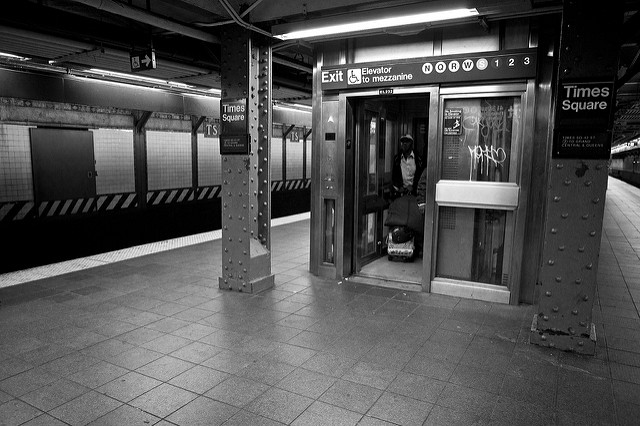Calling the New York City subway system “the least accessible in the country,” disability advocates announced that they filed two class action lawsuits against the MTA for “excluding people with disabilities.” One lawsuit against the agency, filed in state court, claims a huge majority of the system’s stations are inaccessible to people who can’t use stairs. The other, filed in federal court, accuses the MTA of negligence in maintaining the elevators that the system does have.
In a press release announcing the lawsuits, nonprofit legal center Disability Rights Advocates point out that 80% of the city’s subway stations are inaccessible to anyone using a walker, wheelchair, scooter or otherwise lacking the ability to get down stairs. The lack of accessible subway stations can be seen starkly in this map from 2015 that showed huge swathes of the system that aren’t ADA-accessible. Since they’ve left so many of the stations in the city without elevators, 80% according to advocates, the MTA is in violation of the city’s Human Rights Law, according to the suit.
“The lack of elevators doubles my commute time, at best. And if just one elevator is out of service, I’m stuck,” plaintiff Sasha Blair-Goldensohn said in a statement announcing the suit. “I never know when I’ll have to ask strangers to carry me up the stairs in my wheelchair. It’s nerve-wracking, dangerous and degrading.”
Even for the stations that do have elevators, advocates claim the MTA is coming up short. 25 station elevators are out across the system on any day, according to Disability Rights Advocates, and the ones that are actually running are full of trash and urine. And as shown in the case of accessibility advocate Edith Prentiss, even the elevators that work could still stall with a passenger on them.
“Both the lack of elevators and the frequent breakdowns make wheelchair users like myself very vulnerable. And to make matters worse, when an elevator is non-operative, there are rarely any warnings or announcements in stations and no contingency plan to assist people in my situation,” another plaintiff, Dustin Jones, said.
“The MTA has been committed to serving the needs of disabled customers through subway service, fully accessible bus service and the MTA’s Access-A-Ride (paratransit) program,” MTA spokesperson Beth DeFalco told Gothamist in a statement. “That commitment continues to be evident in our current Capital Plan where we are spending more than $1 billion to increase the number of ADA-compliant subway stations and replace existing elevators and escalators. We cannot comment on pending litigation – therefore we can’t address these specific lawsuits.”
Because the “speed, frequency, convenience, and relatively low cost of a subway ride are unmatched by any of New York City’s alternate modes of transportation” according to the text of the state lawsuit, Disability Rights Advocates are asking for a legal order compelling the MTA to make the whole system accessible “over a reasonable period of time.” In the federal suit, DRA seeks a court order for a system-wide policy across the subways that would ensure elevators are clean and in working order, and that outages and other service interruptions come with “adequate notice and alternative accommodations.”
The MTA also contends that even with the age of the subway system taken into consideration, it’s doing its best to make more of the system accessible, with 117 of the stations currently classified as ADA-accessible. The agency also says that they’re working to make 25 more stations accessible with their current funding, but that it would cost almost $10 billion to make all stations in the system ADA-compliant.
Source: gothamist.com




